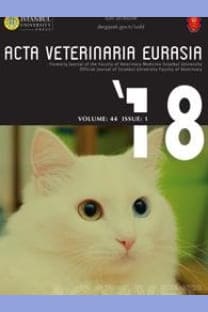Electrocardiography Parameters Recorded With Holter Monitoring in Sport and Work Horses Before and After Physical Activity
___
Bakos, Z., Louise, L., 2009. Reference values of Holter electrocardiography in normal horses. Indian Veterinary Journal 9, 3-7.Bowen, I.M., 2010. Ambulatory electrocardiography and heart rate variability. Cardiology of the Horse, Second Edition, Saunders Elsevier 127-137. [CrossRef]
Božić, T., 2007. Patološka fiziologija domaćih životinja, Fakultet Medicine, Beograd, 157-165.
Dinu, C., Dojana, N., Mitranescu, E., Avram, N., Cuca, D., Parvu, M., Berghes, C., 2007. Electrocardiographic and haematological parameters and heart beat frequency in Arabian Thoroughbred horses according to their adaptability to effort. Lucrări Stiintifice Medicină Veterinară 40, 397-401.
Einthoven, W., 1912. The different forms of the human electrocardiogram and their signification. Lancet 179, 853-861. [CrossRef]
Fazio, F., Ferrantelli, V., Piccione, G., Caola, G., 2003. Variations in some electrocardiographic parameters in the trotter during racing and training. Veterinary Research Communications 27, 229-232. [CrossRef]
Fregin, G., 1982. The equine electrocardiogram with standardized body and limb positions. Cornell Veterinarian 72, 304.
Kroneman, J., 1997. Krankheiten Des Kardiovaskulären Systems. In: Wintzer, H.-J. (Ed.), Krankheiten des Pferdes. Parey Buchverlag, Berlin, Pp 131-133.
Mantovani, M.M., Tsuruta, S.A., Muzzi, R.A.L., Machado, T., Pádua, M.F.S., Coimbra, C., Muzzi, L.A.L., Jacomini, J.O., 2013. Electrocardiographic study in the American Quarter Horse breed. Arquivo Brasileiro de Medicina Veterinária e Zootecnia 65, 1389-1393. [CrossRef]
Ohmura, H., Jones, J.H., 2017. Changes in heart rate and heart rate variability as a function of age in Thoroughbred horses. Journal of Equine Science 28, 99-103. [CrossRef]
Pozderac, Ž., 2010. Značaj otkrivanja simptoma kardiovaskularnih oboljenja kroz poremećaje srčanog ritma analiziranih 24 h Holtermonitoringom srca i krvnog pritiska kod studenata Univerziteta u
Sarajevu, University of Sarajevo, Sarajevo, 45-66. Sabev, S.P., Kanakov, D.T., Petkov, P.I., 2010. Electrocardiographic response to exercise in race horses during the training season, Bulgarian Journal of Veterinary Medicine 13, 55-60.
Schwarzwald, C.C., Kedo, M., Birkmann, K., Hamlin, R.L., 2012. Relationship of heart rate and electrocardiographic time intervals to body mass in horses and ponies. Journal of Veterinary Cardiology 14, 343-350. [CrossRef]
Uhlendorf, F., Gehlen, H., Stadler, P., 2013. Comparison of different electrocardiographic techniques for the detection of arrhythmias in horses. Tierarztliche Praxis, Ausgabe G, Grosstiere/Nutztiere 41, 305- 314. [CrossRef]
Waller, A.D., 1887. A demonstration on man of electromotive changes accompanying the heart’s beat. The Journal of Physiology 8, 229- 234. [CrossRef]
Zucca, E., Ferrucci, F., Fabio, V., Croci, C., Ferro, E., 2003. The use of electrocardiographic recording with Holter monitoring during treadmill exercise to evaluate cardiac arrhythmias in racehorses. Veterinary Research Communications 27, 811-814. [CrossRef]
- ISSN: 2618-639X
- Yayın Aralığı: 3
- Başlangıç: 1975
- Yayıncı: İstanbul Üniversitesi-Cerrahpaşa
Seyramsarah Blossom SETUFE, Benjamin Obukowho EMIKPE, Emmanuel Kolawole AJANI, Samuel Temitope OGUNBANWO
Ndazo Salka MINKA, Joseph Olusegun AYO, Fatima Bukar HASSAN
Onyeka CHIDIEBELE NWUFOH, Nurudeen AYINDE SADIQ, Benjamin Obukowho EMIKPE, Tayo OMOBOWALE
Ermin ALJI, Sabina ERI HARA I, Aida HOD I, Faruk TANDIR, Amel UTUK, Nejra HAD IMUSI
